Corporate Governance Analysis of Australian Listed Company
VerifiedAdded on 2023/06/07
|12
|2666
|285
Report
AI Summary
This report provides a comprehensive analysis of corporate governance, focusing on its principles, theories, and practical application through a case study. It begins by defining corporate governance and outlining its significance in guiding and controlling a firm's operations, emphasizing the importance of transparency, accountability, and stakeholder interests. The report then delves into key theories, including agency, stewardship, and stakeholder theories, explaining their roles in shaping corporate behavior. A case study involving an Australian listed company is examined, highlighting weaknesses such as lack of transparency, earnings management, and conflicts of interest. The analysis identifies specific shortcomings in the company's corporate governance structure, including the appointment of a non-independent director and the manipulation of financial statements. The report concludes by recommending improvements to enhance the company's governance, such as adhering to disclosure requirements, ensuring CEO accountability, and promoting transparency to protect the interests of all stakeholders. The report emphasizes the need for ethical practices and compliance with regulatory standards to foster a robust and effective corporate governance framework.
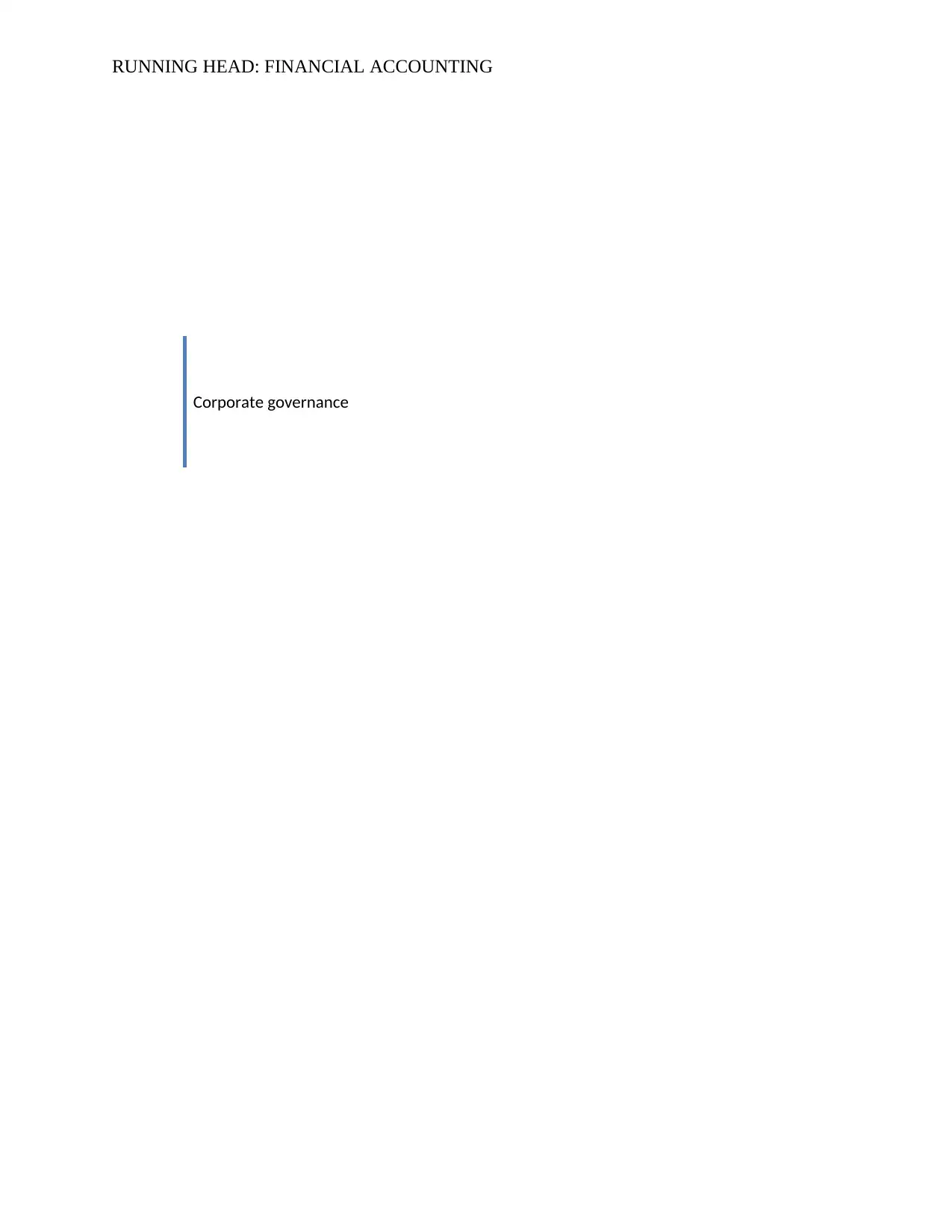
RUNNING HEAD: FINANCIAL ACCOUNTING
Corporate governance
Corporate governance
Paraphrase This Document
Need a fresh take? Get an instant paraphrase of this document with our AI Paraphraser
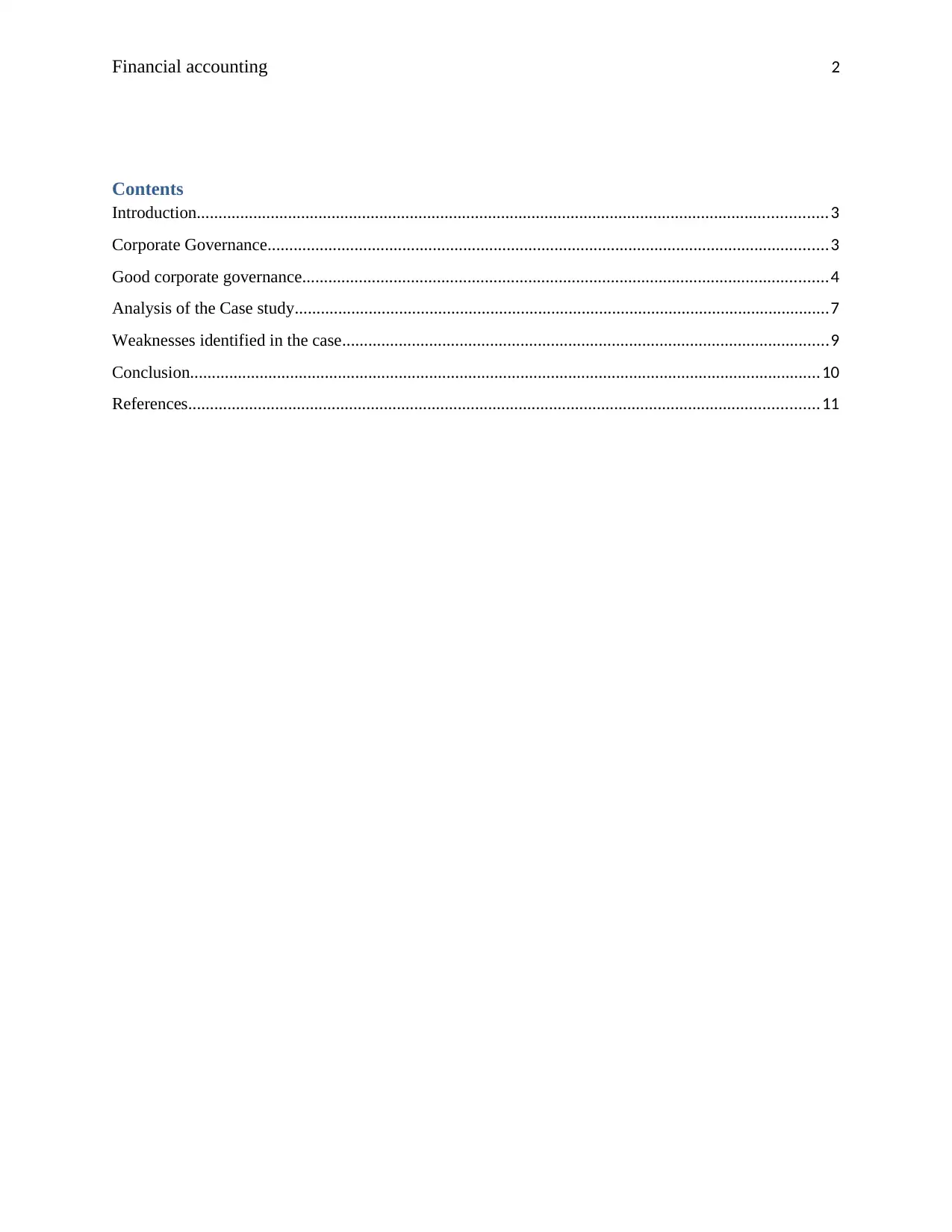
Financial accounting 2
Contents
Introduction.................................................................................................................................................3
Corporate Governance.................................................................................................................................3
Good corporate governance.........................................................................................................................4
Analysis of the Case study...........................................................................................................................7
Weaknesses identified in the case................................................................................................................9
Conclusion.................................................................................................................................................10
References.................................................................................................................................................11
Contents
Introduction.................................................................................................................................................3
Corporate Governance.................................................................................................................................3
Good corporate governance.........................................................................................................................4
Analysis of the Case study...........................................................................................................................7
Weaknesses identified in the case................................................................................................................9
Conclusion.................................................................................................................................................10
References.................................................................................................................................................11

Financial accounting 3
Introduction
The report provides explanation on corporate governance, its theories and weaknesses. It
discusses the characteristics of good corporate governance and explains the theories that support
the same. Furthermore, the report analyses a case study and provide recommendations on its
structure of corporate governance. It identifies its weaknesses and explains the steps to improve
the same in its later part.
Corporate Governance
The system of rules, practices, policies and procedures that guides, directs and controlled a firm
and its operations is known as corporate governance. Company directs its managers to control
and monitor the functioning of a firm in such a way that protects the interest of the shareholders.
It helps in balancing the interest of many stakeholders that includes management, customers,
suppliers, government, investors and community. The concept of corporate governance offers a
framework with the help of which a company can easily attain its objectives and establish
appropriate internal control measures for making the performance effective and efficient (Bajpai,
2016).
In general, it lay down some rules and regulations which direct the corporate behaviour of board
of directors. The board is the key element of corporate governance as it is responsible for making
important and suitable decisions for the firm such as deciding the dividend policies, executive
compensations and many more (Fernando, 2012). There are some principles of Corporate
Governance Council which are been recommended to be followed by every company listed on
Australian Stock Exchange. It includes the process through which the objectives of the entity are
Introduction
The report provides explanation on corporate governance, its theories and weaknesses. It
discusses the characteristics of good corporate governance and explains the theories that support
the same. Furthermore, the report analyses a case study and provide recommendations on its
structure of corporate governance. It identifies its weaknesses and explains the steps to improve
the same in its later part.
Corporate Governance
The system of rules, practices, policies and procedures that guides, directs and controlled a firm
and its operations is known as corporate governance. Company directs its managers to control
and monitor the functioning of a firm in such a way that protects the interest of the shareholders.
It helps in balancing the interest of many stakeholders that includes management, customers,
suppliers, government, investors and community. The concept of corporate governance offers a
framework with the help of which a company can easily attain its objectives and establish
appropriate internal control measures for making the performance effective and efficient (Bajpai,
2016).
In general, it lay down some rules and regulations which direct the corporate behaviour of board
of directors. The board is the key element of corporate governance as it is responsible for making
important and suitable decisions for the firm such as deciding the dividend policies, executive
compensations and many more (Fernando, 2012). There are some principles of Corporate
Governance Council which are been recommended to be followed by every company listed on
Australian Stock Exchange. It includes the process through which the objectives of the entity are
⊘ This is a preview!⊘
Do you want full access?
Subscribe today to unlock all pages.

Trusted by 1+ million students worldwide
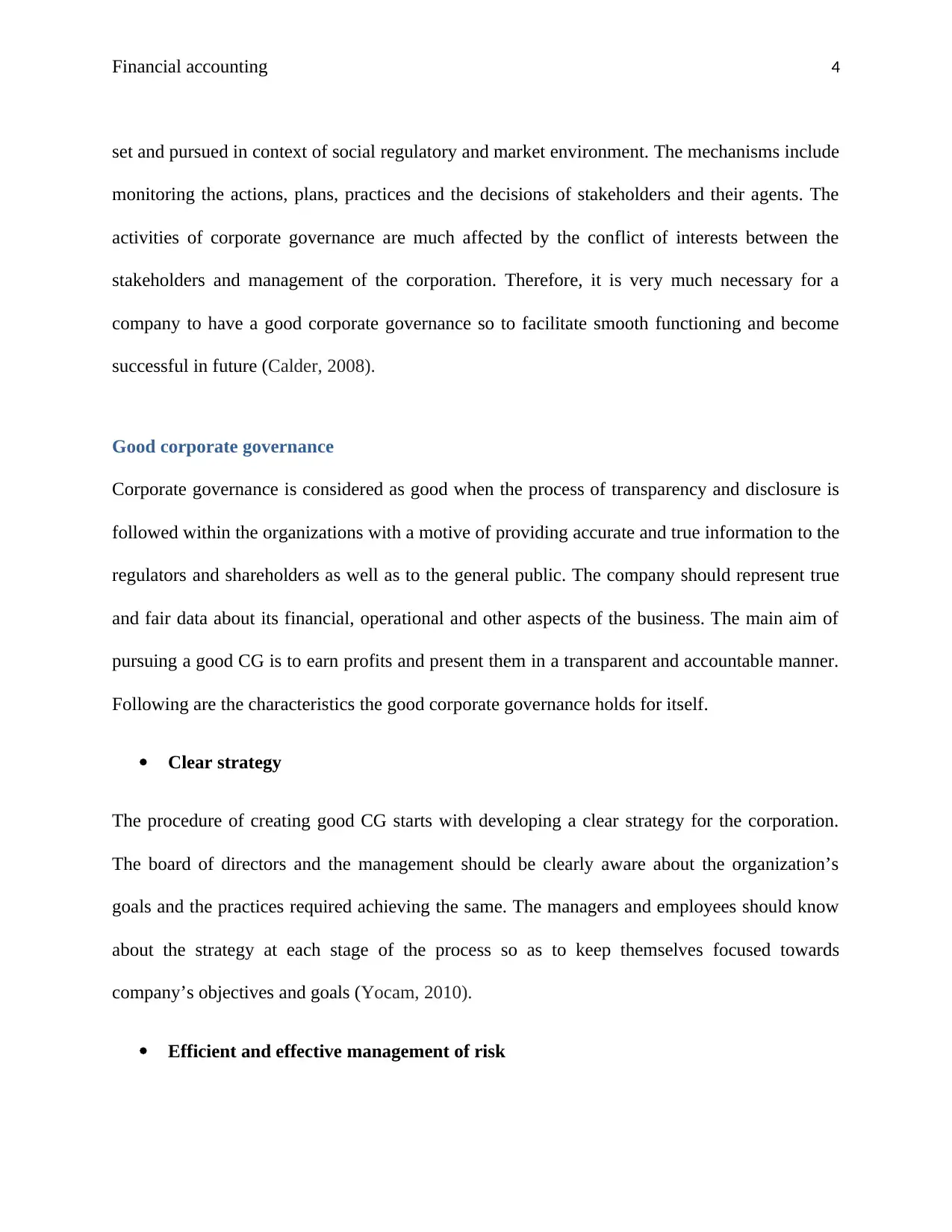
Financial accounting 4
set and pursued in context of social regulatory and market environment. The mechanisms include
monitoring the actions, plans, practices and the decisions of stakeholders and their agents. The
activities of corporate governance are much affected by the conflict of interests between the
stakeholders and management of the corporation. Therefore, it is very much necessary for a
company to have a good corporate governance so to facilitate smooth functioning and become
successful in future (Calder, 2008).
Good corporate governance
Corporate governance is considered as good when the process of transparency and disclosure is
followed within the organizations with a motive of providing accurate and true information to the
regulators and shareholders as well as to the general public. The company should represent true
and fair data about its financial, operational and other aspects of the business. The main aim of
pursuing a good CG is to earn profits and present them in a transparent and accountable manner.
Following are the characteristics the good corporate governance holds for itself.
Clear strategy
The procedure of creating good CG starts with developing a clear strategy for the corporation.
The board of directors and the management should be clearly aware about the organization’s
goals and the practices required achieving the same. The managers and employees should know
about the strategy at each stage of the process so as to keep themselves focused towards
company’s objectives and goals (Yocam, 2010).
Efficient and effective management of risk
set and pursued in context of social regulatory and market environment. The mechanisms include
monitoring the actions, plans, practices and the decisions of stakeholders and their agents. The
activities of corporate governance are much affected by the conflict of interests between the
stakeholders and management of the corporation. Therefore, it is very much necessary for a
company to have a good corporate governance so to facilitate smooth functioning and become
successful in future (Calder, 2008).
Good corporate governance
Corporate governance is considered as good when the process of transparency and disclosure is
followed within the organizations with a motive of providing accurate and true information to the
regulators and shareholders as well as to the general public. The company should represent true
and fair data about its financial, operational and other aspects of the business. The main aim of
pursuing a good CG is to earn profits and present them in a transparent and accountable manner.
Following are the characteristics the good corporate governance holds for itself.
Clear strategy
The procedure of creating good CG starts with developing a clear strategy for the corporation.
The board of directors and the management should be clearly aware about the organization’s
goals and the practices required achieving the same. The managers and employees should know
about the strategy at each stage of the process so as to keep themselves focused towards
company’s objectives and goals (Yocam, 2010).
Efficient and effective management of risk
Paraphrase This Document
Need a fresh take? Get an instant paraphrase of this document with our AI Paraphraser
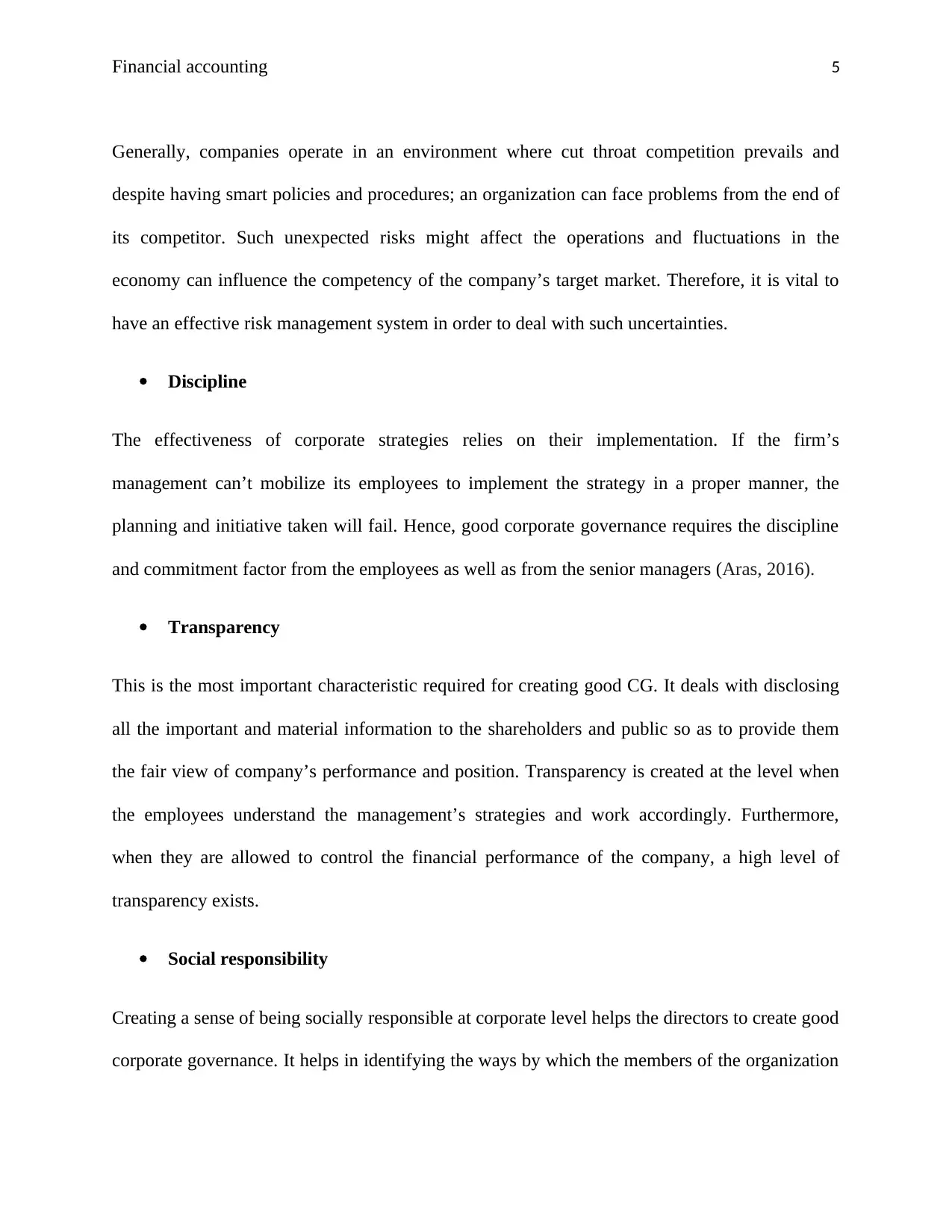
Financial accounting 5
Generally, companies operate in an environment where cut throat competition prevails and
despite having smart policies and procedures; an organization can face problems from the end of
its competitor. Such unexpected risks might affect the operations and fluctuations in the
economy can influence the competency of the company’s target market. Therefore, it is vital to
have an effective risk management system in order to deal with such uncertainties.
Discipline
The effectiveness of corporate strategies relies on their implementation. If the firm’s
management can’t mobilize its employees to implement the strategy in a proper manner, the
planning and initiative taken will fail. Hence, good corporate governance requires the discipline
and commitment factor from the employees as well as from the senior managers (Aras, 2016).
Transparency
This is the most important characteristic required for creating good CG. It deals with disclosing
all the important and material information to the shareholders and public so as to provide them
the fair view of company’s performance and position. Transparency is created at the level when
the employees understand the management’s strategies and work accordingly. Furthermore,
when they are allowed to control the financial performance of the company, a high level of
transparency exists.
Social responsibility
Creating a sense of being socially responsible at corporate level helps the directors to create good
corporate governance. It helps in identifying the ways by which the members of the organization
Generally, companies operate in an environment where cut throat competition prevails and
despite having smart policies and procedures; an organization can face problems from the end of
its competitor. Such unexpected risks might affect the operations and fluctuations in the
economy can influence the competency of the company’s target market. Therefore, it is vital to
have an effective risk management system in order to deal with such uncertainties.
Discipline
The effectiveness of corporate strategies relies on their implementation. If the firm’s
management can’t mobilize its employees to implement the strategy in a proper manner, the
planning and initiative taken will fail. Hence, good corporate governance requires the discipline
and commitment factor from the employees as well as from the senior managers (Aras, 2016).
Transparency
This is the most important characteristic required for creating good CG. It deals with disclosing
all the important and material information to the shareholders and public so as to provide them
the fair view of company’s performance and position. Transparency is created at the level when
the employees understand the management’s strategies and work accordingly. Furthermore,
when they are allowed to control the financial performance of the company, a high level of
transparency exists.
Social responsibility
Creating a sense of being socially responsible at corporate level helps the directors to create good
corporate governance. It helps in identifying the ways by which the members of the organization

Financial accounting 6
can be responsible towards their customers. The good CG assists in improving the practices and
procedures as well as it promotes the social good by reinvesting in the local community.
Apart from the above characteristics, there are various theories of corporate governance which
states the features of creating good CG for the organization. They are as follows:
Agency Theory
The theory was developed by Alchian and Demsetz (1972) and further explained by Jensen and
Meckling (1976). It basically explains the relationship between the principal and its agent. At
corporate level, shareholders are treated as principal and the executives and managers of the
organizations are considered as agents. The theory suggests that the agents have to work in
interest of principal and take decisions in their interest only (Farrar, 2008). However, the same
may not necessarily take place and agency problems may arise in future. Overall, it focuses on
the fact that employees and managers are held responsible and accountable for their tasks and
responsibilities. Therefore, they should focus on creating good governance structure rather than
just emphasizing on the need of shareholders (Abdullah & Valentine, 2009).
Stewardship Theory
It was defined by Davis, Schoorman & Donaldson (1997) as the steward’s main objective is to
maximize and protect the shareholder’s wealth by improving performance of the firm. As per
this perspective, stewards are company’s employees, managers and executives who are working
for the shareholders and in their interest (Clarke, 2004). The theory does not focus on the concept
of individualism like agency theory; instead it promotes the role of top management and suggests
that the stewards are motivated and satisfied when the objectives of the firm are met.
can be responsible towards their customers. The good CG assists in improving the practices and
procedures as well as it promotes the social good by reinvesting in the local community.
Apart from the above characteristics, there are various theories of corporate governance which
states the features of creating good CG for the organization. They are as follows:
Agency Theory
The theory was developed by Alchian and Demsetz (1972) and further explained by Jensen and
Meckling (1976). It basically explains the relationship between the principal and its agent. At
corporate level, shareholders are treated as principal and the executives and managers of the
organizations are considered as agents. The theory suggests that the agents have to work in
interest of principal and take decisions in their interest only (Farrar, 2008). However, the same
may not necessarily take place and agency problems may arise in future. Overall, it focuses on
the fact that employees and managers are held responsible and accountable for their tasks and
responsibilities. Therefore, they should focus on creating good governance structure rather than
just emphasizing on the need of shareholders (Abdullah & Valentine, 2009).
Stewardship Theory
It was defined by Davis, Schoorman & Donaldson (1997) as the steward’s main objective is to
maximize and protect the shareholder’s wealth by improving performance of the firm. As per
this perspective, stewards are company’s employees, managers and executives who are working
for the shareholders and in their interest (Clarke, 2004). The theory does not focus on the concept
of individualism like agency theory; instead it promotes the role of top management and suggests
that the stewards are motivated and satisfied when the objectives of the firm are met.
⊘ This is a preview!⊘
Do you want full access?
Subscribe today to unlock all pages.

Trusted by 1+ million students worldwide
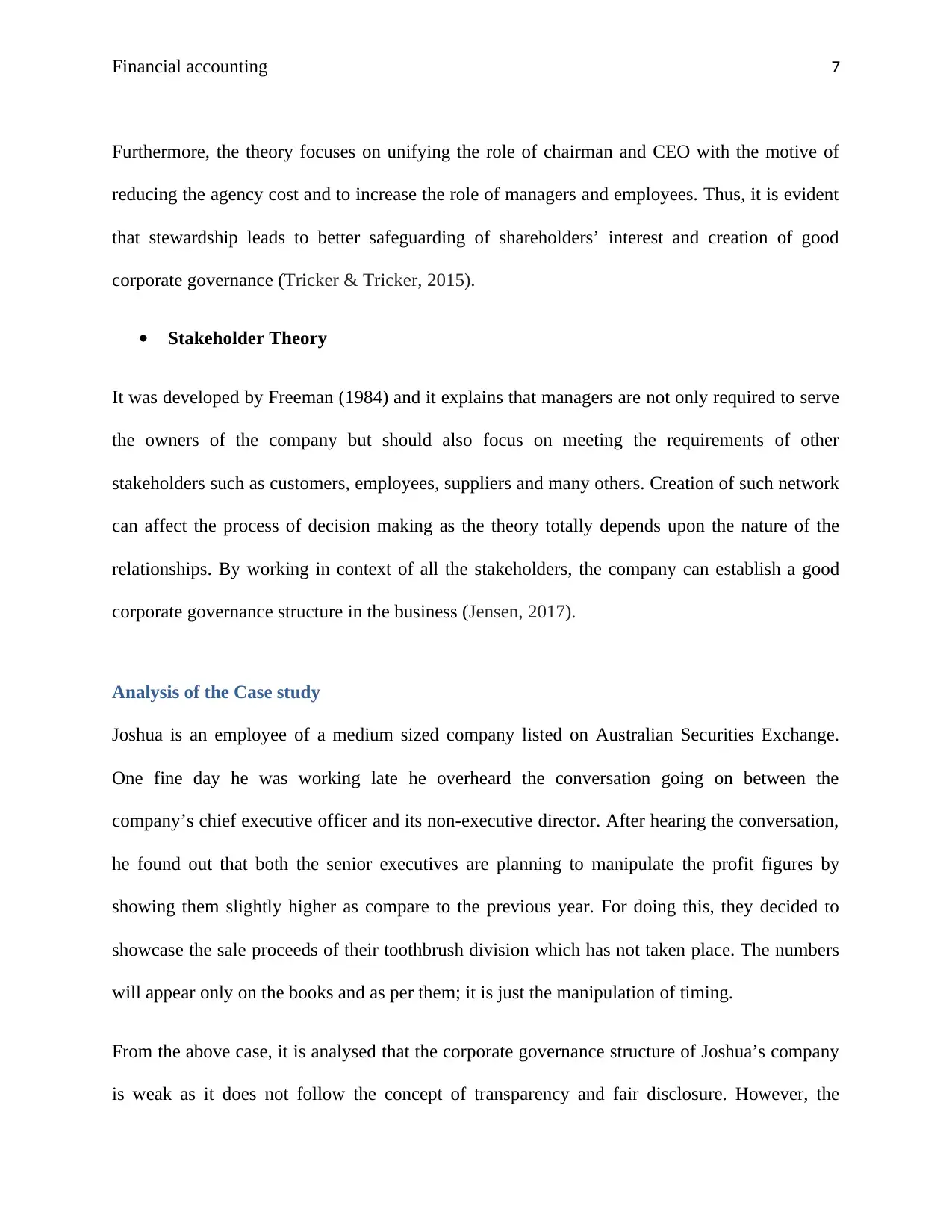
Financial accounting 7
Furthermore, the theory focuses on unifying the role of chairman and CEO with the motive of
reducing the agency cost and to increase the role of managers and employees. Thus, it is evident
that stewardship leads to better safeguarding of shareholders’ interest and creation of good
corporate governance (Tricker & Tricker, 2015).
Stakeholder Theory
It was developed by Freeman (1984) and it explains that managers are not only required to serve
the owners of the company but should also focus on meeting the requirements of other
stakeholders such as customers, employees, suppliers and many others. Creation of such network
can affect the process of decision making as the theory totally depends upon the nature of the
relationships. By working in context of all the stakeholders, the company can establish a good
corporate governance structure in the business (Jensen, 2017).
Analysis of the Case study
Joshua is an employee of a medium sized company listed on Australian Securities Exchange.
One fine day he was working late he overheard the conversation going on between the
company’s chief executive officer and its non-executive director. After hearing the conversation,
he found out that both the senior executives are planning to manipulate the profit figures by
showing them slightly higher as compare to the previous year. For doing this, they decided to
showcase the sale proceeds of their toothbrush division which has not taken place. The numbers
will appear only on the books and as per them; it is just the manipulation of timing.
From the above case, it is analysed that the corporate governance structure of Joshua’s company
is weak as it does not follow the concept of transparency and fair disclosure. However, the
Furthermore, the theory focuses on unifying the role of chairman and CEO with the motive of
reducing the agency cost and to increase the role of managers and employees. Thus, it is evident
that stewardship leads to better safeguarding of shareholders’ interest and creation of good
corporate governance (Tricker & Tricker, 2015).
Stakeholder Theory
It was developed by Freeman (1984) and it explains that managers are not only required to serve
the owners of the company but should also focus on meeting the requirements of other
stakeholders such as customers, employees, suppliers and many others. Creation of such network
can affect the process of decision making as the theory totally depends upon the nature of the
relationships. By working in context of all the stakeholders, the company can establish a good
corporate governance structure in the business (Jensen, 2017).
Analysis of the Case study
Joshua is an employee of a medium sized company listed on Australian Securities Exchange.
One fine day he was working late he overheard the conversation going on between the
company’s chief executive officer and its non-executive director. After hearing the conversation,
he found out that both the senior executives are planning to manipulate the profit figures by
showing them slightly higher as compare to the previous year. For doing this, they decided to
showcase the sale proceeds of their toothbrush division which has not taken place. The numbers
will appear only on the books and as per them; it is just the manipulation of timing.
From the above case, it is analysed that the corporate governance structure of Joshua’s company
is weak as it does not follow the concept of transparency and fair disclosure. However, the
Paraphrase This Document
Need a fresh take? Get an instant paraphrase of this document with our AI Paraphraser

Financial accounting 8
executives used the concept of earnings management in order to show high profits on their books
of accounts. This will eventually help them to retain their best and potential investors and attract
the new ones also. The term earnings reflect the net income of the business earned during a
particular period of time. It is the most important component that reflects the overall financial
position and performance of the entity. The managers and executives can go to any extent to
keep their earnings high and mange them properly. Given such importance, it can be said that the
management has great interest in knowing how their earnings are been reported on the books.
The concept of earnings management deals with taking legal and meaningful decisions in respect
to financial reporting. However, the notion is always mixed with illegal activities where the
executives are manipulating their earnings to show high and increased profits for their company
(Francis & Schipper, 2011).
In the case study, the CEO and non-executive director tried to manage their earnings and show
high profits so that they can keep their large investors and shareholders in the business. For this
purpose, they reported the sales of their toothbrush division on the books but it did not take place
in real till October. However, such action is against the characteristic of good corporate
governance and once noticed may affect the performance of the organization and its employees.
Their actions reflected some sort of discrepancies in the company’s corporate governance
structure. Moreover, the conversation was overhead by the employee Joshua which can have a
negative impact on its performance as well as may stimulate the change in his behaviour towards
the company.
executives used the concept of earnings management in order to show high profits on their books
of accounts. This will eventually help them to retain their best and potential investors and attract
the new ones also. The term earnings reflect the net income of the business earned during a
particular period of time. It is the most important component that reflects the overall financial
position and performance of the entity. The managers and executives can go to any extent to
keep their earnings high and mange them properly. Given such importance, it can be said that the
management has great interest in knowing how their earnings are been reported on the books.
The concept of earnings management deals with taking legal and meaningful decisions in respect
to financial reporting. However, the notion is always mixed with illegal activities where the
executives are manipulating their earnings to show high and increased profits for their company
(Francis & Schipper, 2011).
In the case study, the CEO and non-executive director tried to manage their earnings and show
high profits so that they can keep their large investors and shareholders in the business. For this
purpose, they reported the sales of their toothbrush division on the books but it did not take place
in real till October. However, such action is against the characteristic of good corporate
governance and once noticed may affect the performance of the organization and its employees.
Their actions reflected some sort of discrepancies in the company’s corporate governance
structure. Moreover, the conversation was overhead by the employee Joshua which can have a
negative impact on its performance as well as may stimulate the change in his behaviour towards
the company.

Financial accounting 9
Weaknesses identified in the case
There are some weaknesses identified in the corporate governance of Australian company. One
of them is the appointment of non-executive director, Alan who is the cousin of company’s chief
executive officer Paul. Both the members have close family connection and therefore the director
cannot be considered as independent on his appointment. Another limitation was noticed in the
role of CEO. The officer is held responsible for all executive management matters affecting the
company. He is accountable to the chairman and is required to perform his duties and
responsibilities with honesty and due diligence. However, the same is not reflected in the case
study as the CEO Paul was involved in manipulation of financial statements along with the
director Alan. They both decided to increase the profit figures by showing the false sales of their
toothbrush segment. This is considered as the weakness in the role of CEO as he did not ensure
the true and fair disclosure of all the information.
Furthermore, the corporate governance of the company also lacks transparency in its system. The
modification of accounts and presentation of faulty image reflects that there was no transparency
in company’s practices and procedures. The annual report of the company did not provide all the
material information to its users and potential investors. It misguided them and presented a false
image of entity’s financial performance and position. Overall, the governance focused only on
the interest of investors and did not consider the needs and goals of other people of the
organization. The main and prominent weakness was that it did not comply with the corporate
governance disclosure requirements and other ASX CGC principles. The structure failed to
follow the concept of transparency and objectives of financial reporting. Thus, it can be
Weaknesses identified in the case
There are some weaknesses identified in the corporate governance of Australian company. One
of them is the appointment of non-executive director, Alan who is the cousin of company’s chief
executive officer Paul. Both the members have close family connection and therefore the director
cannot be considered as independent on his appointment. Another limitation was noticed in the
role of CEO. The officer is held responsible for all executive management matters affecting the
company. He is accountable to the chairman and is required to perform his duties and
responsibilities with honesty and due diligence. However, the same is not reflected in the case
study as the CEO Paul was involved in manipulation of financial statements along with the
director Alan. They both decided to increase the profit figures by showing the false sales of their
toothbrush segment. This is considered as the weakness in the role of CEO as he did not ensure
the true and fair disclosure of all the information.
Furthermore, the corporate governance of the company also lacks transparency in its system. The
modification of accounts and presentation of faulty image reflects that there was no transparency
in company’s practices and procedures. The annual report of the company did not provide all the
material information to its users and potential investors. It misguided them and presented a false
image of entity’s financial performance and position. Overall, the governance focused only on
the interest of investors and did not consider the needs and goals of other people of the
organization. The main and prominent weakness was that it did not comply with the corporate
governance disclosure requirements and other ASX CGC principles. The structure failed to
follow the concept of transparency and objectives of financial reporting. Thus, it can be
⊘ This is a preview!⊘
Do you want full access?
Subscribe today to unlock all pages.

Trusted by 1+ million students worldwide
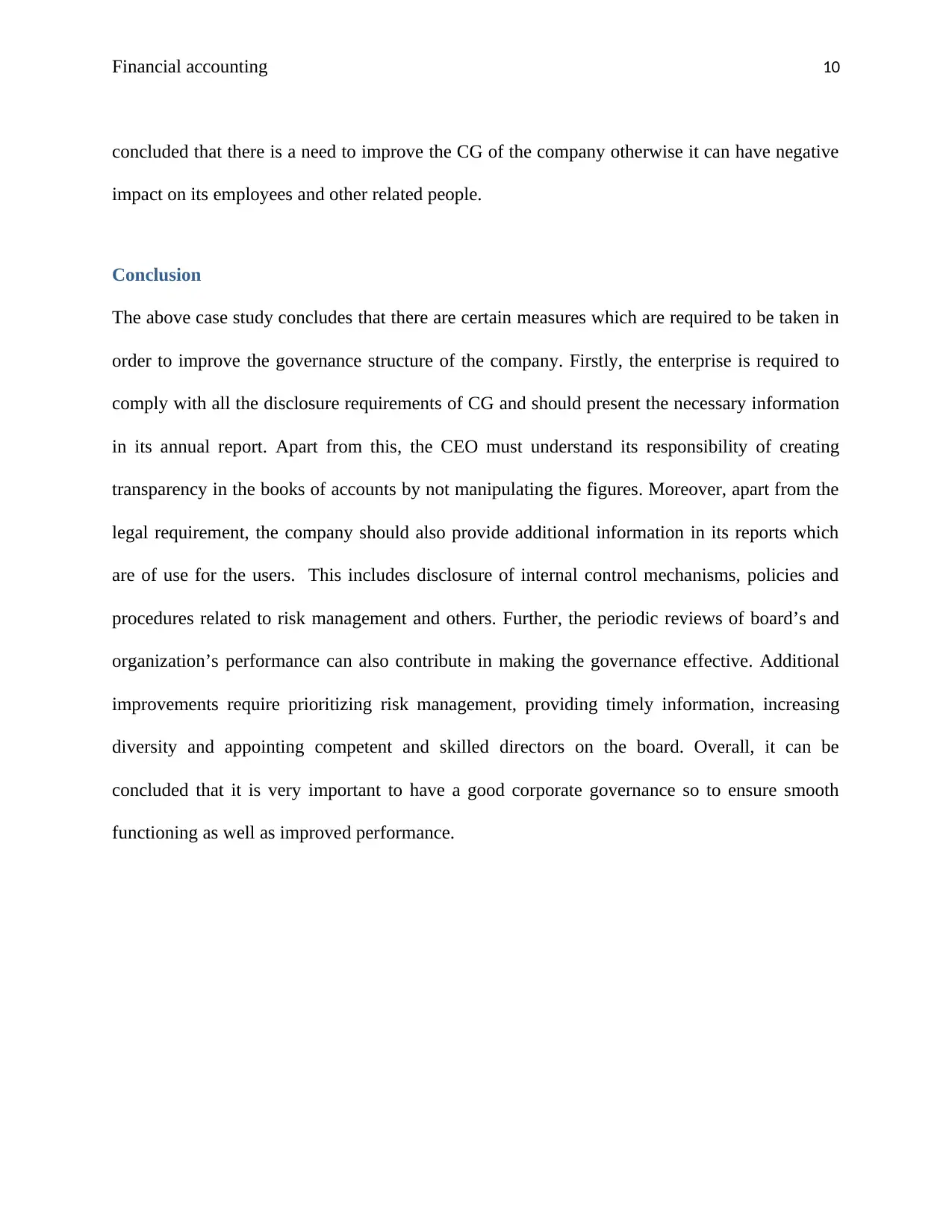
Financial accounting 10
concluded that there is a need to improve the CG of the company otherwise it can have negative
impact on its employees and other related people.
Conclusion
The above case study concludes that there are certain measures which are required to be taken in
order to improve the governance structure of the company. Firstly, the enterprise is required to
comply with all the disclosure requirements of CG and should present the necessary information
in its annual report. Apart from this, the CEO must understand its responsibility of creating
transparency in the books of accounts by not manipulating the figures. Moreover, apart from the
legal requirement, the company should also provide additional information in its reports which
are of use for the users. This includes disclosure of internal control mechanisms, policies and
procedures related to risk management and others. Further, the periodic reviews of board’s and
organization’s performance can also contribute in making the governance effective. Additional
improvements require prioritizing risk management, providing timely information, increasing
diversity and appointing competent and skilled directors on the board. Overall, it can be
concluded that it is very important to have a good corporate governance so to ensure smooth
functioning as well as improved performance.
concluded that there is a need to improve the CG of the company otherwise it can have negative
impact on its employees and other related people.
Conclusion
The above case study concludes that there are certain measures which are required to be taken in
order to improve the governance structure of the company. Firstly, the enterprise is required to
comply with all the disclosure requirements of CG and should present the necessary information
in its annual report. Apart from this, the CEO must understand its responsibility of creating
transparency in the books of accounts by not manipulating the figures. Moreover, apart from the
legal requirement, the company should also provide additional information in its reports which
are of use for the users. This includes disclosure of internal control mechanisms, policies and
procedures related to risk management and others. Further, the periodic reviews of board’s and
organization’s performance can also contribute in making the governance effective. Additional
improvements require prioritizing risk management, providing timely information, increasing
diversity and appointing competent and skilled directors on the board. Overall, it can be
concluded that it is very important to have a good corporate governance so to ensure smooth
functioning as well as improved performance.
Paraphrase This Document
Need a fresh take? Get an instant paraphrase of this document with our AI Paraphraser
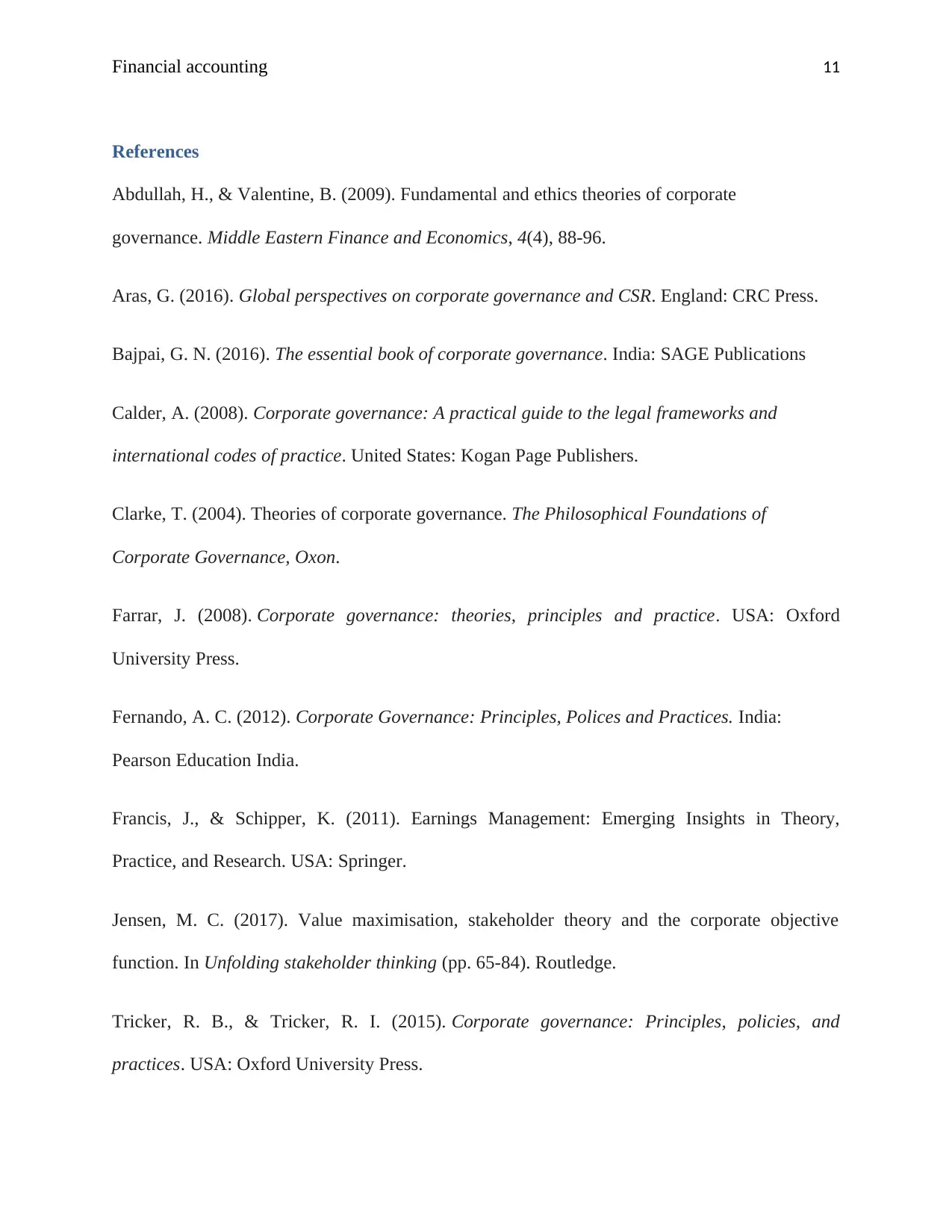
Financial accounting 11
References
Abdullah, H., & Valentine, B. (2009). Fundamental and ethics theories of corporate
governance. Middle Eastern Finance and Economics, 4(4), 88-96.
Aras, G. (2016). Global perspectives on corporate governance and CSR. England: CRC Press.
Bajpai, G. N. (2016). The essential book of corporate governance. India: SAGE Publications
Calder, A. (2008). Corporate governance: A practical guide to the legal frameworks and
international codes of practice. United States: Kogan Page Publishers.
Clarke, T. (2004). Theories of corporate governance. The Philosophical Foundations of
Corporate Governance, Oxon.
Farrar, J. (2008). Corporate governance: theories, principles and practice. USA: Oxford
University Press.
Fernando, A. C. (2012). Corporate Governance: Principles, Polices and Practices. India:
Pearson Education India.
Francis, J., & Schipper, K. (2011). Earnings Management: Emerging Insights in Theory,
Practice, and Research. USA: Springer.
Jensen, M. C. (2017). Value maximisation, stakeholder theory and the corporate objective
function. In Unfolding stakeholder thinking (pp. 65-84). Routledge.
Tricker, R. B., & Tricker, R. I. (2015). Corporate governance: Principles, policies, and
practices. USA: Oxford University Press.
References
Abdullah, H., & Valentine, B. (2009). Fundamental and ethics theories of corporate
governance. Middle Eastern Finance and Economics, 4(4), 88-96.
Aras, G. (2016). Global perspectives on corporate governance and CSR. England: CRC Press.
Bajpai, G. N. (2016). The essential book of corporate governance. India: SAGE Publications
Calder, A. (2008). Corporate governance: A practical guide to the legal frameworks and
international codes of practice. United States: Kogan Page Publishers.
Clarke, T. (2004). Theories of corporate governance. The Philosophical Foundations of
Corporate Governance, Oxon.
Farrar, J. (2008). Corporate governance: theories, principles and practice. USA: Oxford
University Press.
Fernando, A. C. (2012). Corporate Governance: Principles, Polices and Practices. India:
Pearson Education India.
Francis, J., & Schipper, K. (2011). Earnings Management: Emerging Insights in Theory,
Practice, and Research. USA: Springer.
Jensen, M. C. (2017). Value maximisation, stakeholder theory and the corporate objective
function. In Unfolding stakeholder thinking (pp. 65-84). Routledge.
Tricker, R. B., & Tricker, R. I. (2015). Corporate governance: Principles, policies, and
practices. USA: Oxford University Press.
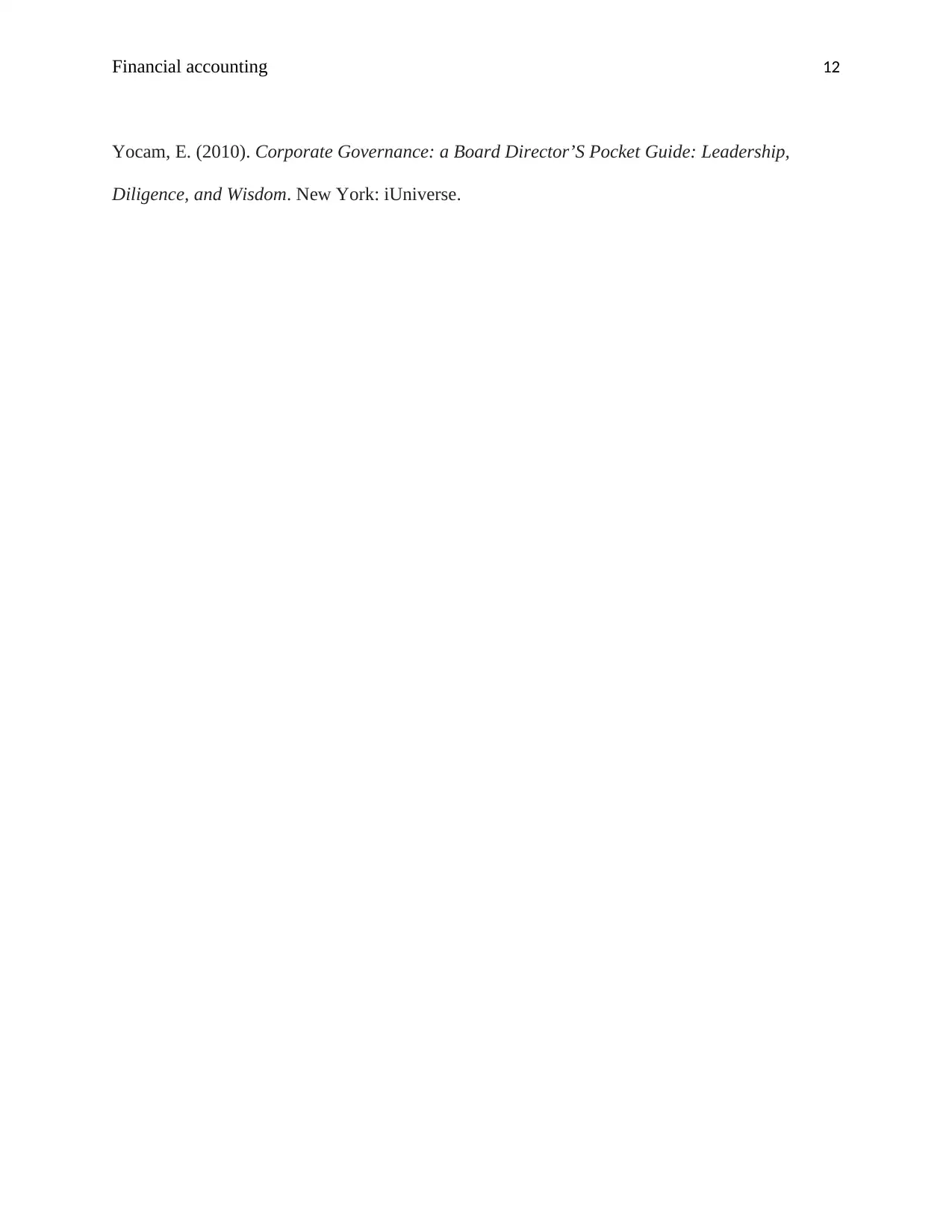
Financial accounting 12
Yocam, E. (2010). Corporate Governance: a Board Director’S Pocket Guide: Leadership,
Diligence, and Wisdom. New York: iUniverse.
Yocam, E. (2010). Corporate Governance: a Board Director’S Pocket Guide: Leadership,
Diligence, and Wisdom. New York: iUniverse.
⊘ This is a preview!⊘
Do you want full access?
Subscribe today to unlock all pages.

Trusted by 1+ million students worldwide
1 out of 12
Related Documents
Your All-in-One AI-Powered Toolkit for Academic Success.
+13062052269
info@desklib.com
Available 24*7 on WhatsApp / Email
![[object Object]](/_next/static/media/star-bottom.7253800d.svg)
Unlock your academic potential
Copyright © 2020–2025 A2Z Services. All Rights Reserved. Developed and managed by ZUCOL.





